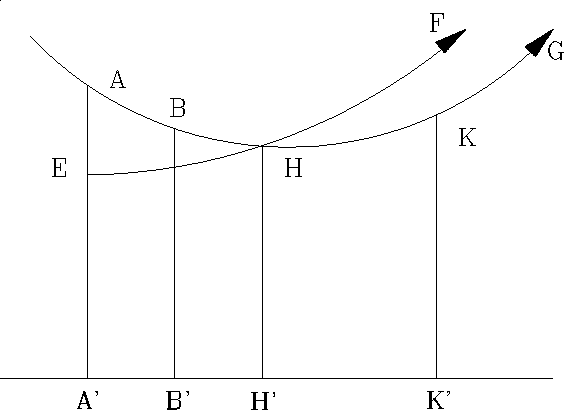We have defined two types of parallel lines--hyperparallel and horoparallel. Are these the only types of parallel lines in hyperbolic geometry? Are there lines that are both hyperparallel and limiting parallel? These are the questions that we wish to answer in this section.
Theorem 13.12: Let ![]() be the limiting parallel ray to
be the limiting parallel ray to
![]() through P and let Q and X' be the feet of P and X,
respectively, in
through P and let Q and X' be the feet of P and X,
respectively, in ![]() . Then PQ>XX'.
. Then PQ>XX'.

Proof: If ![]() then
then ![]() by
Theorem 14.5. Thus,
by
Theorem 14.5. Thus, ![]() is the angle of parallelism for X
and
is the angle of parallelism for X
and ![]() . Thus, it is acute. Therefore,
. Thus, it is acute. Therefore, ![]() is obtuse. This
implies that
is obtuse. This
implies that ![]() and therefore PQ>XX'.
and therefore PQ>XX'.
This shows that the distance form X to ![]() decreases as the distance from
P to X increases along the limiting parallel ray. In fact, one can show
that the distance from X to
decreases as the distance from
P to X increases along the limiting parallel ray. In fact, one can show
that the distance from X to ![]() approaches 0. Note that we have seen
that for hyperparallel lines the further one gets from the common
perpendicular, the greater the distance between the lines. This gives one the
impression that these types of parallel lines should be distinct.
approaches 0. Note that we have seen
that for hyperparallel lines the further one gets from the common
perpendicular, the greater the distance between the lines. This gives one the
impression that these types of parallel lines should be distinct.
Corollary 1: If ![]() in a given direction, then
in a given direction, then ![]() and
k have no common perpendicular.
and
k have no common perpendicular.
Proof: Let ![]() so that
so that ![]() and assume that
there is a point
and assume that
there is a point ![]() so that
so that
This tells us that if two lines are limiting parallel, then they are not hyperparallel. We now need to show that if two lines are non-intersecting and are not limiting parallel, then they must be hyperparallel. Having done this we will then know that there are only two types of parallel lines.
Theorem 13.13: Given lines m and n so that
Then ![]() , and
, and
![]() .
.

Proof: We need to find two points ![]() that are equidistant from
m; i.e.,
that are equidistant from
m; i.e., ![]() . If this is true, then by Theorem 14.11 the
perpendicular bisector of HK is the common perpendicular to m and n. By
Theorem 14.11 this common perpendicular is unique. It follows then that
. If this is true, then by Theorem 14.11 the
perpendicular bisector of HK is the common perpendicular to m and n. By
Theorem 14.11 this common perpendicular is unique. It follows then that
![]() .
.
(i) The search for H and K.
Let ![]() with feet
with feet ![]() . If
. If ![]() we are done. Assume
that these segments are not congruent. Then, we may assume that AA'>BB',
since one must be greater than the other. There is a point
we are done. Assume
that these segments are not congruent. Then, we may assume that AA'>BB',
since one must be greater than the other. There is a point ![]() so that
so that
![]() .
.
There is a unique ray ![]() on the same side of
on the same side of ![]() as B so
that
as B so
that ![]() with
with ![]() .
.
CLAIM: ![]() . (Proof will
follow.)
. (Proof will
follow.)
Call this point of intersection H. The there is a unique point
![]() so that
so that ![]() . Then, by SAS
. Then, by SAS ![]() . Thus,
. Thus, ![]() . We also have that
. We also have that ![]() , so that by Angle Subtraction it follows that
, so that by Angle Subtraction it follows that
![]() . Since HH' and KK' are perpendicular to
m, we have by Hypotenuse-Angle that
. Since HH' and KK' are perpendicular to
m, we have by Hypotenuse-Angle that ![]() . Therefore,
. Therefore, ![]() , and H and K are equidistant from m.
, and H and K are equidistant from m.
Thus, we are finished once we have proved the claim.
It turns out that the claim is the hardest item to prove in the whole theorem. It takes us through some strange territory.